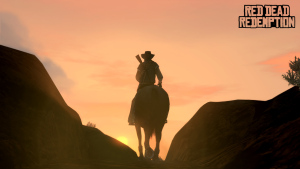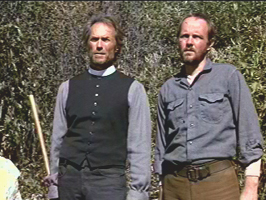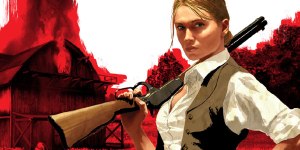Red Dead Resolution

Good-bye, John Marston. We'll see you around.
To readers and fellow gamers mired in the southern portion of the game’s virtual geography, I say “press on!” After the initial “New Austin” portion of the storyline, the “Mexico” chapters are a bit of a disappointment. Progress is more tentative. The clichés are more offensive. Even though the territory is smaller, one seems to spend more time in transit on one’s horse. There’s an ill-advised stealth portion of the game with unreasonably lethal throwing knives. (Seriously, it can take a couple of shots to stop a guy who’s trying to kill you, but one throwing knife in the back puts your man down, every time. Are the things poisoned? The game never says anything about poison.)
But when you come back to the US, and gain access to the “West Elizabeth” territory (which is actually the easternmost potion of the game’s geography. Go figure), it’s all worth it. This is where Red Dead Redemption’s early hints that it wants to be a game about the end of the West and the conflict between the open frontier and creeping industrialized bureaucracy really come to fruition. [Let it be said that there are rather severe SPOILERS AHEAD, but if you really want some quality spoilers, go to the Red Dead Wiki. It’s pretty fabulous.]
Suddenly, in West Elizabeth’s largest town, Blackwater, it starts to feel like 1911 and not the 1870s. The streets are paved. You take a ride in (and make fun of) a car, which, of course, breaks down at a critical moment. You’re able to purchase a pretty sweet full-automatic German Mauser pistol, and you finally get to work face-to-face with the corrupt federal agent who’s been pulling your strings. (He’s been hovering in the background during the early portions of the game.) But most importantly, after all this, you do actually get your family back. And that’s not where the game ends.

He'll take your confession, and offer the absolution of cold steel
After riding all over the West, killing and being shot at, John Marston gets to go home to his own property and try to reconnect with his family. Even though I knew it was coming, John’s reunion with his wife, Abigail was surprisingly affecting. Abigail, when you meet her, is a great character. She loves John, but she won’t take any shit from anyone, especially him. She has as much of a past as John does—she was a “working girl” who ran with old gang John has just killed off, and she has mixed feelings about that. In short, she’s a character worth all of the trouble you’ve just gone through. (Compare, say, to Super Mario Bros., in its various incarnations. What did Toadstool or Peach ever do for you?) The scene where Abigail meets Bonnie McFarlane, the rancher who saved John’s life and is more than a little sweet on him, is perfectly played. The two women have a lot in common, and like each other. The only sign of Bonnie’s feelings is the way the camera (can we call it the camera?—the game’s view) lingers on Bonnie as she watches John and Abigail drive away. It’s heartbreaking.

As great as Abigail is, I think that Bonnie McFarlane is actually the best part of the game, and kudos to Rockstar for that.
It’s not quite Unforgiven, but it’s worthy of being mentioned in the same sentence.
If I had one complaint (other than Mexico), it’s that I’d like to be able to bump into the characters from the main storyline again in the game’s coda. (You are given brief updates on what happens to most of them in a newspaper you can purchase. Do.) I’d like to know what happens to McFarlane and her ranch. I’d like to get to see her meet Marston’s son. I’ve made an emotional connection with these characters, and that’s an extraordinary thing to be able to say about a game.
—
Gavin Craig is co-editor of The Idler. You can follow him on Twitter at @craiggav.
Comments
4 Responses to “Red Dead Resolution”Trackbacks
Check out what others are saying...-
[…] a particularly intense gaming experience? If not, then let me be the first unhappy volunteer. Last week I wrote about the joy of finishing a great video game. This week every pixel seems less intense, […]
-
[…] than Red Dead Redemption, which seems to be an Idler consensus favorite from 2010, my practice is normally to wait until I can pay $20-$30 to pick up a game […]
Having just entered the Blackwater portion of the game myself I must admit to being a little taken aback by how jarring the transition was (in a good way). It’s really impressive to wander into a clean, well-lit, paved community after hauling ass through the deserts of Mexico for so long. Well timed and kind of breathtaking.
Gav, you should check out The Wild Bunch if you haven’t yet. A great scene where the outlaws encounter an automobile; also a terrific incursion into Mexico, which becomes (strangely) the real/new/old West.